#polenta chips
Explore tagged Tumblr posts
Video
youtube
Hands down the Best Polenta Chips Ever!
1 note
·
View note
Text
something I would not recommend doing is splashing your arm with hot fat
0 notes
Text
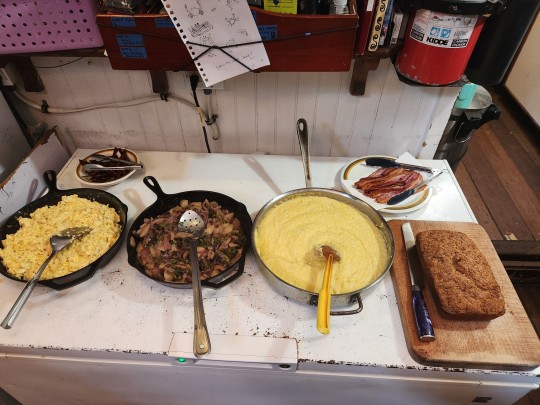
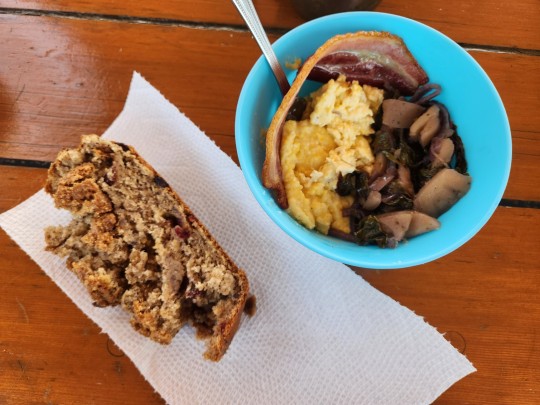
Good morning! Brunch today was polenta, melted apples (with caramelized onion and wilted chard), cheesy scrambled eggs, bacon, and cinnamon cranberry bread (recipe below the cut). Technically the chard was supposed to be separate but I tossed them in with the other veg to save space and give them some more flavor- I also did the polenta like it is in the apples recipe, though I used half coconut cream and half water, and added nutritional yeast instead of cheese to keep it vegan.
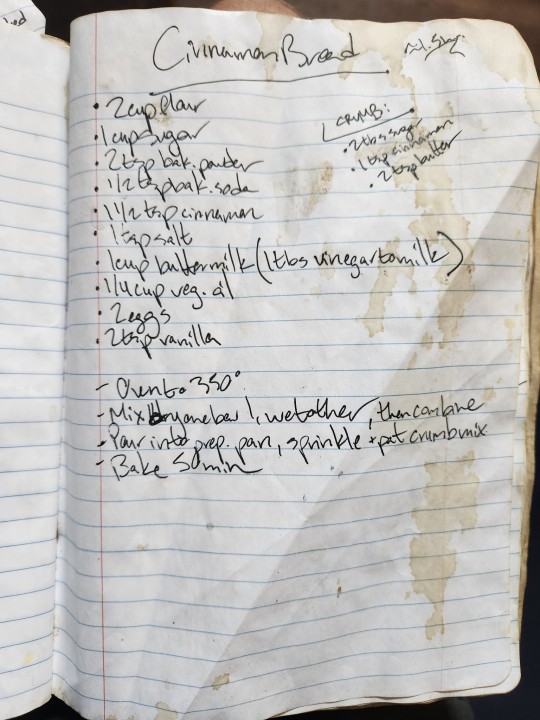
Y'all get to see inside my messy three year old recipe book XD there's also some alterations I've started doing that aren't listed in the recipe, I'll put those at the end. Also that I've been making a vegan version this year!
Transcription:
Cinnamon Bread, makes one loaf, takes about an hour to an hour and a half.
2 cup flour
1 cup sugar
2 tsp baking powder
1/2 tsp baking soda
1 1/2 tsp cinnamon
1 tsp salt
1 cup buttermilk (1 tbs [apple cider] vinegar to [1 cup] milk)
1/4 cup veg oil
2 eggs
2 tsp vanilla
Crumb: 2 tbs sugar, 1 tsp cinnamon, 2 tsp butter
- oven to 350°
- mix dry in one bowl, wet in other, then combine
- pour into prepped pan, sprinkle and pat down crumb mix
- bake 50 min [or until toothpick comes out clean]
Now, my alterations! I've cut down the cinnamon to 1 tsp specifically so I could also add in 1/4 tsp each nutmeg and cardamom, and a sprinkle of allspice. I also like to sometimes mix in either chocolate chips or cranberries (this one was the latter).
To make it vegan, I switch out the buttermilk for vegan yogurt (or just oat milk if I don't have any on hand), and replace the eggs with ground flaxseed at a 1 egg to one tbs ratio, and add 3 tbs oat milk per egg (so, 2 tbs flax and 6 tbs milk)
I'm also... kinda lazy when it comes to the crumb. I've taken to just sprinkling brown sugar over the top and it comes out just fine lmao
25 notes
·
View notes
Text









Celiac Friendly Recipes:
Creamy Vodka Pasta Sauce
Easy Vanilla Cake
The Best Gluten Free Pizza
Gluten Free Chocolate Chip Cookies
The Best Vegan Burgers
Gluten Free Brownies
Sheet Pan Ratatouille With Crispy Baked Tofu With Polenta
Raw Vegan Blueberry Cheesecake
1-Pot Vegan “Barbacoa” Tacos
I did not include oats because some people with celiac disease are affected by them too, even if they’re gluten free ones.
#collections#glutenfree#gluten free#celiac disease#celiac#gluten intolerance#gluten allergy#food allergies#autoimmine disease#autoimmune diseases#allergy friendly#recipe#recipes#vegan#food#veganism#vegetarian#plantbased#plant based#foodporn#food porn#foodpics#food photography#cooking#baking#govegan#go vegan#veganfood#vegan food#what vegans eat
17 notes
·
View notes
Text

Anchor's Point Inn
Evermore's beloved landmark!
Starters
Smoked Bjoulsae Hake cakes: Creamy fishcakes, with dill tartare sauce
Fried rabbit bites, with tangy honey-whiskey barbecue sauce
Battered Halcyon Lake frog legs, with sweet brown butter sauce
Chevre-stuffed zucchini flowers, with harissa and 'nduja dip
Mains
Hammerfell-style grilled Bjoulsae eel fillets, with sweet and savoury sauce and sticky rice
Battered Lake Snapper filet, with polenta chips and dill tartare sauce
Viridian Woods venison cordon bleu, with serrano ham and Northglen gruyere
Spinach and brie baguette, with creamed spinach, melted brie, and caramelised onion chutney
Desserts
Hallin's Stand baklava, with pistachios and whipped cream
Caramelised apple tart, with clotted cream
Daedra food cake: Fiendishly fudgy dark chocolate cake, with red berry coulis
Carrot Cheesecake, with spiced cookie crumble
#Two menus in one day my my you're spoiled#Menu#fantasy menu#the elder scrolls#tes#food#cooking#world building#worldbuilding#Evermore#Bangkorai#High Rock#Breton
181 notes
·
View notes
Text
28 notes
·
View notes
Note
ok but i actually do wanna know what you have to say about foodways and “european culture” and colonialism so…please say more??
First things first: every Spaniard and Italian owes endless reparations for how heavily they rely on tomatoes for various national dishes.
Italians owe extra reparations for the way they've claimed the tomato as *their* vegetable.
Like, not only are these (tomatoes and potatoes) specifically only in Europe because of colonization, but their history as part of indigenous food culture has been all but obliterated in public consciousness.
I wrote this out in tags on another post, but I recently had a friend's kid say that fish and grits seemed like it should be British (the obvious association being fish and chips--incidentally, you don't have fish and chips without the colonial absorption of potatoes as a critical foodstock and mass effort to promote and expand the cultivation throughout Europe). I immediately was like, 'whoa, this is super American.'
Not like, for jingoistic or nationalist purposes but because on so many levels we ignore the indigenous roots of common foods. Much like potatoes and tomatoes, corn (whether as a milled starch in the form of meal, corn starch, polenta, or grits) has become integral to a lot of traditional European cuisine.
What is upsetting about it all is that the peoples who spent generations encouraging corn to go from a couple of funky kernels on a weird wheat stalk, who cultivated thousands of distinct varieties of potatoes made for near every purpose you can imagine, and bred the wealth of tomatoes from which we can pick out one perfectly suited to just about any type of snacking get hardly any credit.
In most food histories or chef profiles you get these farm-to-table moments that describe some kinship with produce and reverence for land and blah blah blah. But OFTEN when it's a white chef they talk as if these ingredients just came from nothing. As if it's their birthright. And sure, everyone has a relationship to food. Being fed and sustained *is* our birthright.
But it's also taken, right? It's also something that only exists (in European imagination) for ~600 years. Which sounds like a lot. But it's a fraction of the thousands of years of relation between the peoples of the Americas and the foods we now rely on.
This is kind of rambling and disconnected, and I'm using vv broad language because I'm feeling lazy about pulling out references. But I suggest listening to any of the whetstone media podcasts about foodways and agricultural histories. They're really good/useful, succinct jumping off points for a variety of different facets of food history.
10 notes
·
View notes
Text
Getting Started
Clear the decks. Take everything out of your pantry, give it a hard look and decide what you can get rid of. Be ruthless. If you haven’t used it in a year, get rid of it.
Keep what looks and smells good. “Expiration,” “sell by,” and “best by” dates are not good guidelines. Some are determined by regulators, others by manufacturers, and almost all are arbitrary. Properly stored, some (unopened) ingredients, like canned fish, can last for years; others, like dried herbs, start declining in quality the moment they are sealed in a container.
Assess what remains. Then organize it according to the logic that makes sense to you: There’s no single best system. Your nut butters might be with the condiments, or the breakfast items, or the baking supplies.
Fill in the blanks with food that will make you a better cook. Each of the pantry lists below is a proposal, not a prescription. There’s no reason to stock black beans if you only like red. There’s no need to have everything here available at all times. You’ll know your pantry is well stocked for your purposes when most of the time, you need only add one or two fresh ingredients to cook one of our recipes from scratch. Or even better, none.
The Essential Pantry
The foundation layer for all three pantries, this is where everyone should start. There’s so much to be done with these basics. The rule here is stock your pantry mostly with what you’re confident using, and what you love to eat. You’ll turn to it again and again.
Oils and vinegars: Extra-virgin olive oil, neutral cooking oil (such as canola or grapeseed), red-wine vinegar, white vinegar or white-wine vinegar.
Cans and jars: Tuna in olive oil, tomato paste, diced tomatoes, tomato sauce, chicken stock or vegetable stock (box-packed tastes better than canned). A good-tasting, simple tomato sauce can become a soup or a stew, or make a quick dinner with pasta or polenta.
Spices and dried herbs: Kosher salt, red-pepper flakes, ground cayenne, curry powder, bay leaves, black peppercorns, sweet paprika, ground cinnamon, ground cumin, garlic powder or granulated garlic, dried thyme and dried oregano. This selection will take you through everything from a basic beef stew to Saturday morning pancakes to Thanksgiving dinner.
Grains and starches: Long-grain white rice, one or two other grains (such as quinoa or farro), dry pasta (one long, one short and chunky), plain bread crumbs, crackers, canned beans (white beans, black beans and-or chickpeas), dry lentils.
Nuts and nut butters: Walnuts, almonds, roasted peanuts, peanut butter (smooth and crunchy).
Sweeteners: Honey, maple syrup, granulated sugar.
Preserves and pickles: Fruit jams and preserves, anchovies.
Condiments and sauces: Basic vinaigrette, mustard (yellow or Dijon), mayonnaise, ketchup, hot sauce, salsa, soy sauce.
Produce: Garlic, onions, all-purpose potatoes (such as Yukon Gold), lemons, shelf-stable tofu (Essential for vegetarians, Expanded for others).
Dairy: Eggs, unsalted butter, cheeses (Cheddar, Jack or Colby, Parmesan), milk or cream for cooking (not skim).
Freezer: Chicken parts, sausages, thick fish fillets, shrimp, thick-sliced bread (for toast), spinach (and other vegetables such as corn and peas), berries (and other fruit such as peaches and mango). Some fruits and vegetables take particularly well to freezing — and in most growing seasons, the quality is better than fresh. Frozen fruit is useful for baking and smoothies.
Baking: All-purpose flour, cornmeal, rolled oats, cornstarch, baking soda, baking powder, pure vanilla extract, light brown sugar, dark brown sugar, confectioners’ sugar, bittersweet baking chocolate, semisweet chocolate chips, raisins or another dried fruit, cocoa powder. With these ingredients on hand, thousands of cookies, brownies, cakes, muffins, quick breads and other sweets can be produced without a trip to the store.
The Expanded Pantry
For the cook who has a grasp of the basics, but wants to be able to stretch toward new options and flavors. Here, long-lasting, punchy ingredients like tahini, hoisin sauce, coconut milk, sherry vinegar and capers are stocked alongside classics: limes with lemons, jasmine rice as well as long-grain, almond butter in addition to peanut butter.
Oils and vinegars: Peanut oil, coconut oil, sesame oil, sherry or balsamic vinegar, apple-cider vinegar.
Cans and jars: Sardines, unsweetened coconut milk, whole Italian plum tomatoes, beef stock (box-packed tastes better than canned). Whole plum tomatoes are rarely called for in recipes, but they tend to be the ripest and best-quality fruit. They can be diced or crushed to use in a recipe — or drained and slow-roasted for an intense topping on omelets, salads, grain bowls or pizza.
Spices: Flaky salt, single-chile powders (such as ancho and pasilla), ground coriander, turmeric, smoked paprika, cardamom, za’atar, allspice, fennel seeds, dry mustard, garam masala (a basic Indian mix of warm spices), five-spice powder (a basic Chinese mix of spices), whole nutmegs.
Grains and starches: Rice noodles, basmati or jasmine rice, brown rice, panko bread crumbs, dry beans.
Nuts and nut butters: Almond butter, tahini, pecans.
Preserves and pickles: Olives (oil-cured and-or in brine), capers in brine. These ingredients, served with good bread and butter, make an elegant appetizer with wine, or everyday snack.
Condiments and sauces: Worcestershire sauce, hoisin, Thai red curry paste, fish sauce, anchovy paste, harissa.
Produce: Russet potatoes, carrots, celery, limes, ginger, avocados, parsley, cilantro, scallions, jalapeños. Keeping chiles, aromatics and herbs on hand gives you instant access to intensely fresh flavors, even for — maybe especially for — the simplest dishes you cook.
Dairy: Plain full-fat yogurt, more intense cheeses (pecorino, feta), salted butter.
Freezer: Pancetta, artichoke hearts, homemade stock, homemade bread crumbs, fresh pasta, vegetables (cauliflower, broccoli, cut and peeled winter squash, chopped onions), cooked grains. Prepared ingredients like chopped onions and cooked grains speed your route to dinner.
Baking: Cake flour, whole-wheat flour, dark baking chocolate, vanilla beans, almond extract, powdered gelatin, molasses, light corn syrup, buttermilk powder, active dry yeast.
The Expert Pantry
For the cook who likes taking global flavors, new methods and viral recipes for a spin. Here, the chiles get hotter, the chocolates darker and the cheeses funkier. These ingredients are just a fraction of what’s out there, but by stocking them, you will be able to cook almost any recipe you come across and experiment with creating your own.
Spices: Hot smoked paprika (pimentón), sumac, cumin seeds, coriander seeds, flaky dried chiles (such as Aleppo, Urfa or Maras), dried whole chiles (like ancho and arból), marjoram, dukkah, baharat, shichimi. Whether you stock spice mixes like baharat (a mix of warm spices used in the Middle East) or shichimi (a Japanese blend of ground chiles and sesame seeds) will depend on the global flavors that most appeal to you.
Grains and starches: Short-grain rice, dried pastas (bucatini, mezzi rigatoni or farfalle), spelt, pearl barley.
Nuts and nut butters: Pine nuts, hazelnuts, pumpkin seeds (pepitas), pistachios. Toasted nuts like these (not as everyday as almond and peanuts) are good in salads and granola, on roasted fish, or just with olives for a classic pre-dinner snack.
Preserves and pickles: Pickled hot peppers, cornichons, kimchi, preserved lemons, roasted chiles, horseradish, caperberries, dried sausages such as saucisson sec and chorizo. The intense flavors of pickled and salted ingredients can be a great pick-me-up for mild dishes. In cooking, you can often substitute a bit of preserved lemon for regular lemon, or use the brine from cornichons as part of the liquid in a recipe.
Condiments and sauces: Gochujang, mango chutney, miso, wasabi, dark soy sauce, Chinese oyster sauce, Asian chili bean pastes.
Produce: Shallots, fresh mint, fresh rosemary, lemongrass, fresh Serrano and Thai bird chiles, fresh bay leaves.
Dairy: Ghee, crème fraîche, aged cheeses (Gruyère, blue cheese). Ghee (Indian-style clarified butter) and crème fraîche can reach much higher temperatures than butter, yogurt and sour cream without burning or breaking, so they are useful in cooking.
Freezer: Edamame, curry leaves, makrut lime leaves, merguez (spicy lamb sausages from North Africa). Fragrant leaves like makrut lime and curry (not the spice mix, but an Indian tree with scented leaves) are much more powerful in frozen form than dried.
Baking: Bread flour, pectin, almond flour, tapioca pearls, rose and orange flower waters, gelatin sheets, black cocoa, currants, fresh yeast, sparkling sugar, pearl sugar, candied citrus rinds
Best Practices
Once you have your ingredients, remember that cooking will always create change and disorder. Cans of tomatoes may never match, spices may never live in matching containers, and your hot sauce collection may always try to take over the condiment shelf. But here are a few final thoughts on how to keep your pantry well stocked and well organized enough to be truly useful.
ORGANIZING TIPS
Cooks with different styles need different systems. Some people store the jam with the dried fruits and maple syrup; others associate it with peanut butter, mustard and mayonnaise. The best logic is your own, and it may take some time to figure that out.
If you can’t see it, you’re probably not going to use it. A storage space with more shelving is the most efficient configuration for ingredients. Drawers or slide-out shelves also help tremendously with visibility.
Store everything you can in clear containers. Airtight plastic ones are best, and available in many shapes, sizes, and systems. Rectangular shapes make the best use of space.
Keep a roll of painter’s tape and some permanent markers in a kitchen drawer. It’ll help you make quick labels.
MAXIMIZING INGREDIENTS
Be realistic about your habits. It’s great to clean and trim a week’s worth of vegetables at once — but if you’re not going to do that, buy smaller quantities.
Buy ground spices in the smallest quantities you can find (except for spices you use regularly). Specialty companies will ship as little as an ounce, about 3 tablespoons. You’ll save space and produce better, brighter flavors in your food.
Buy fresh herbs. Dried herbs used to be a pantry essential, but most start out with very little flavor and lose it quickly in storage. (A couple of exceptions are dried oregano and dried thyme.) Pick up fresh herbs when you need them for a particular recipe; it’s a better investment of money and storage space.
Buy heavy, shelf-stable ingredients like boxed broth and canned tomatoes in bulk; better yet, order them online to save time and irritation. Almost any delivery service or website will offer a better price on these items than a brick-and-mortar store.
Cooked ingredients are much easier to use up than raw ones. Whether you steam, boil, pan-fry or roast, cook anything in your refrigerator that looks tired. You can always use it in a salad, a grain bowl or a pasta.
6 notes
·
View notes
Text

Herbed Polenta with Parsnip Chips and Maple Butter (via Eat in My Kitchen)
10 notes
·
View notes
Text
D I R E C T O R Y (pt. 4)
Dish Types ~
Bread • Broths • Brownies • Bubble Tea/Boba • Buddha Bowls • Burgers • Cake • Casserole • Chia Pudding • Cocktails • Condiments • Cookies • Charcuterie/Crudités/Platters • Cheesecake • Chips • Crepes • Dessert Soups • Dips • Donuts • Dumplings • Enchiladas • Flatbreads • Fries • Frittata • Fritters • Galettes • Icecream/Nicecream • Iced Tea • Juices • Kanten • Mochi • Mocktails • Muffins • Noodle Bowl • Noodles • Oatmeal • Parfait • Pasta • Pasta Salad • Pastries • Patties/Empanadas • Pancakes • Panna Cotta • Pie • Pizza • Polenta • Popsicles • Porridge • Quiche • Rice Bowl • Rice Cakes • Rice Pudding • Risotto • Salad • Salad Dressings • Sandwiches • Sauces • Skewers • Smoothies • Smoothie Bowls • Soodles (Squash Noodles) • Soups • Spreads • Stews • Stir Fry • Sushi • Tacos • Tamales • Tarts • Tea • Traybake • Waffles • Wraps • Zoodles
16 notes
·
View notes
Text
Not a clue how many vegan followers who enjoy cruises I have, but I want to stick the pictures I took of the main dining room vegan options somewhere, and it may as well be here! We ate at the main dining room five of the seven nights. Will include the night, the official description, my image, and a brief thought.
This was for a seven-day Australian domestic cruise on Royal Caribbean's Brilliance of the Seas. The nights we skipped were days 4 (British night, vegan options were garden salad, butternut squash curry that was available in the buffet anyway, and a vegan berry sundae), and days 6 (Royal Night, the other formal night - vegan options were a citrus/avocado/melon salad, stuffed red bell pepper, and a chilled banana-cocoa custard). Our sailing did not include Mexican Night (disappointingly, some interesting stuff on there!) or Mediterranean Night (exact same items as Bon Voyage).
Day 1: Welcome Aboard

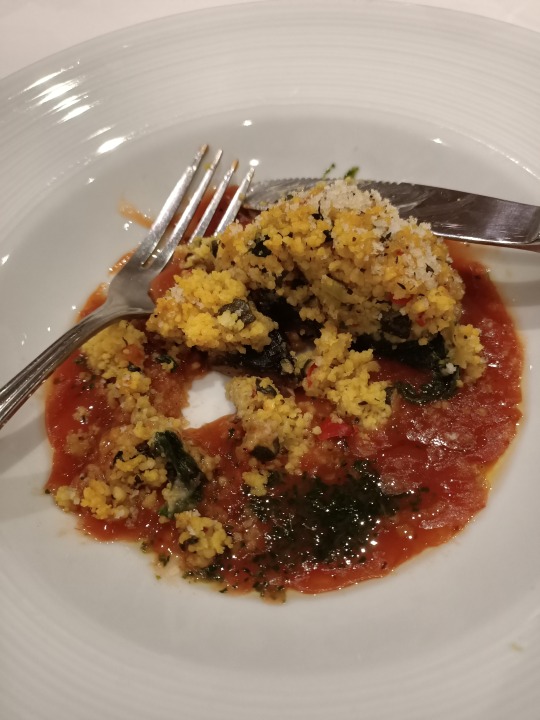

Starter: Roasted Tomato Soup. A blend of seasoned vine-ripened Roma tomatoes topped with crunchy garlic ciabatta croutons and basil pesto.
A very tasty small serve of soup.
Main: Herb-Crusted Stuffed Portobello. With vegan creamed spinach and fluffy vegetable couscous, baked until golden in marinara sauce and herb oil.
Whoops, I started on this one before I took a photo. It was very round! The couscous was good.
Dessert: Peanut-Caramel Bar. Crispy peanut butter rice square with a touch of maple syrup over a sweet mixed berry compote.
No compote, actual fresh berries. I do love peanut butter and caramel, although it did feel fairly simple.
Day 2: Italian Night
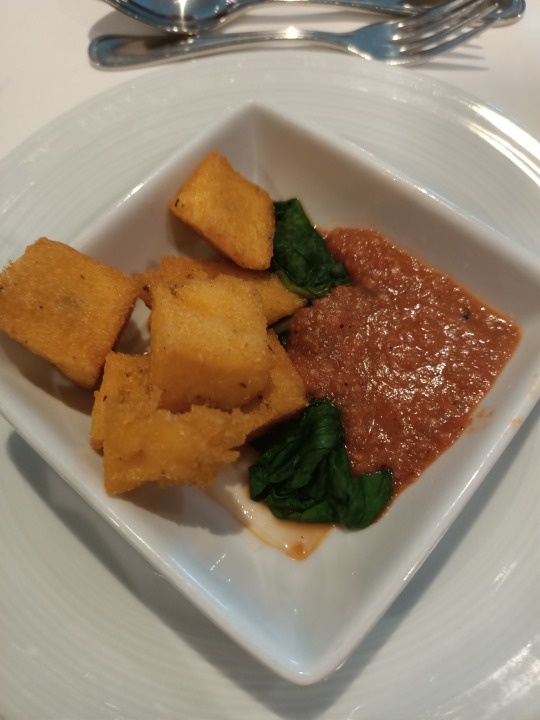


Starter: Golden Polenta Fries with Spicy Dip. Crispy baked corn polenta served with a chilled creamy hazelnut-red pepper spread.
Delish, the sauce was fantastic. Kind of wanted seconds.
Main: Vegan Spaghetti Bolognese. Al dente pasta in a rich marinara sauce with hearty mushrooms and a tofu crumble.
It was... edible! Bizarrely, the tofu crumble seemed to be silken tofu? I got the impression it'd be more parmesan-like. This one was just okay.
Dessert: Crumbly Oat and Berry Bar. Layers of jam and brown-sugar-crusted oats baked fresh and topped with berries and mint.
Very tasty, although again, it felt a bit basic (and there was no mint at all).
Day 3: French Night (formal)



Starter: Creamy Butternut Squash Soup. Roasted harvest squash blended with coconut milk topped with crisp toasted pumpkin seeds.
Only a small serve, but an excellent pumpkin soup.
Main: Spring Pea and Asparagus Risotto. Creamy short-grained rice in simmering pea and mint sauce with jumbo tender asparagus.
Felt... sparse. These are not jumbo asparagus, RC! The peas were either frozen or freeze-dried? Not great. Pretty disappointing for formal night.
Dessert: Dark Chocolate Chip Cookies. Homestyle favorite served with fresh raspberries.
These, at least, were delish. Raspberry, single, lmao. Odd choice for formal night, though.
Day 5: Caribbean Night

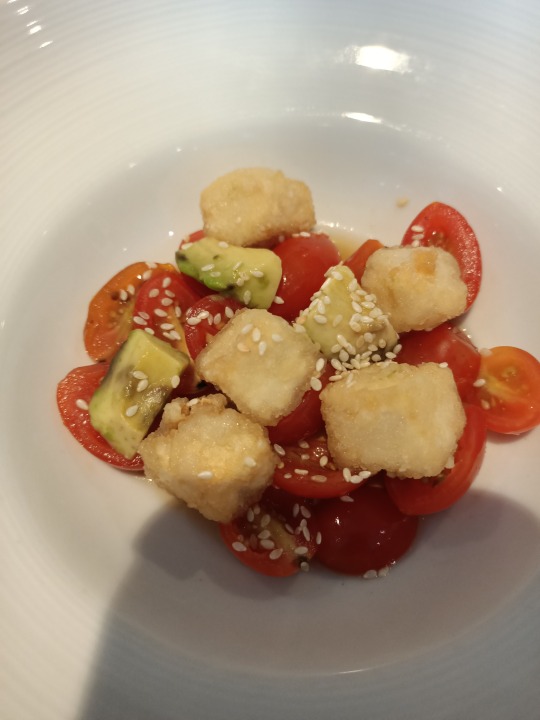
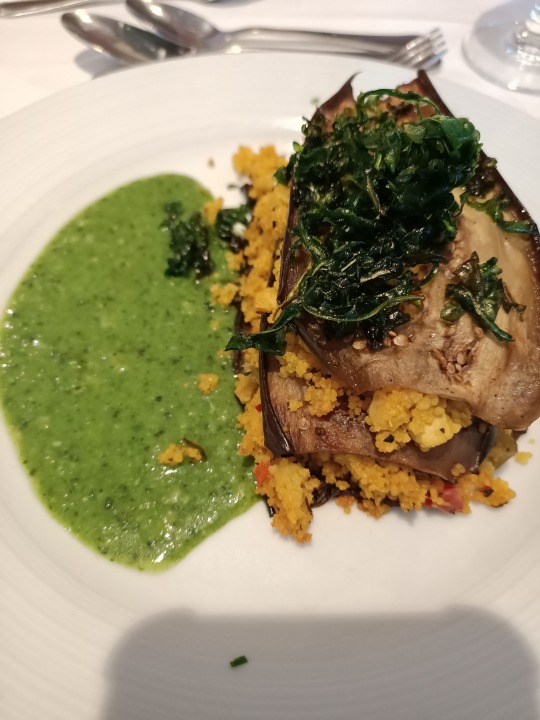
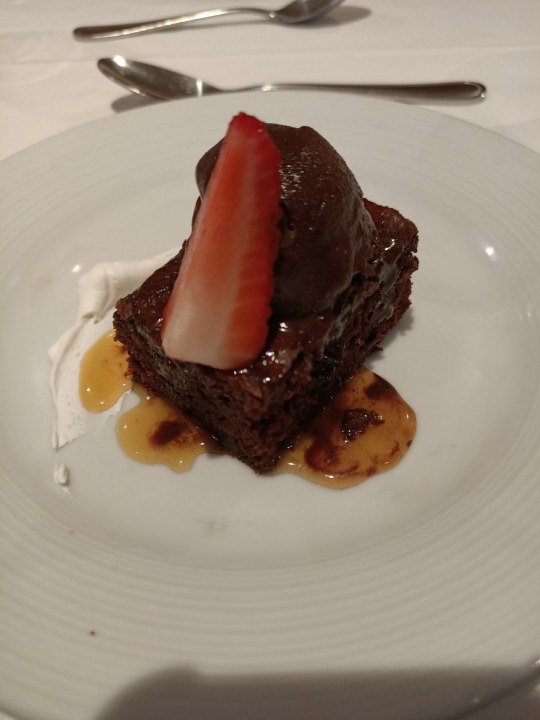
Starter: Green Lentil Soup. Hearty lentils simmered in a San Marzano tomato base with fragrant rosemary. AND Maple-Soy Tofu and Avocado Salad. Chilled marinated tofu tossed with plump grape tomatoes, ripe avocado, and toasted white sesame seeds.
Two, two vegan starters! Got both, for Science. The soup was delish, and the tofu was beautifully done, although avocado lovers would be deeply disappointed by only two little cubes.
Main: Stuffed Grilled Eggplant. Whole wheat couscous with pomegranate seeds and bell peppers layered inside grilled eggplant, with minted cucumber and a spring onion dressing.
No pomegranate to be found, but otherwise extremely tasty.
Dessert: Vegan Fudge Brownie. Rich chocolate brownie with sweet whipped cream and caramel sauce.
The 'cream' felt odd, but the giant scoop of ganache more than made up for it. Delish brownie, very fudgy and much better than the cakey brownies they had up at Windjammer.
Day 7: Bon Voyage



Starter: Pan-Seared Asparagus. Jumbo green asparagus with creamy white bean hummus and a hazelnut-basil pesto drizzle.
Again! These are not jumbo asparagus! Tasted great, especially the hazelnut pesto, and Mum and I both got seconds of it, just... not much to it.
Main: Vegetable Greek Moussaka. Layers of grilled eggplant, Roma tomatoes and tender potatoes and onion, topped with panko breadcrumbs and served with oregano-tomato salsa.
My favourite of the mains, really filling and tasty.
Dessert: Chocolate Cherry Tart. Vanilla tart shell with rich dark chocolate ganache and cherry filling, sweet whipped cream and lemon zest.
No lemon zest, but there was a maraschino cherry! Very tasty, albeit quite hard to eat! (The ganache would slide around on top of the cherry filling.) The whipped cream was a bit overly sweet.
Overall thoughts
Not bad, and there has at least been an attempt! Some items were... weirdly sparse, like the formal night risotto, and the starter serves were sometimes tiny. Also, they do not know the meaning of 'jumbo asparagus', apparently. Some pretty decent desserts, albeit some quite simple. On the plus side, it's not just a scoop of lemon sorbet or some fruit!
Vegans won't go hungry, although you may want a protein shake or bar or something too.
2 notes
·
View notes
Text

The All-Saints Inn
The Temple District's iconic gastropub
Starters
Battered pink oyster mushroom chips, with spicy chorizo marinara
Horse carpaccio, with jazbay grape and roasted pepper jelly
Butternut squash arancini, with buffalo mozzarella filling
Polenta, rosemary, and pecorino wedges, with creamy four-cheese dip
Mains
Pan-fried sweet potato gnocchi, with brown butter sauce, pine nuts, and shaved pecorino
Venison osso buco, with mushroom risotto
Colovian salmon and slaughterfish pierogi, with sour cream and crispy fried onions
Stuffed duck breast, with orange brandy sauce and smoky clove jus
Dessert
Jumbo white chocolate cookie, served warm with cranberry jelly or dark chocolate gelato
Cinnamon apple pie, with spiced cognac and Jerall maple syrup custard
Nirn's Best cake, made with meringue-topped sponge, whipped cream, amaretto custard, and sliced almonds
Blackwood lime pie, with whipped vanilla bean cream
#Menu#Fantasy menu#Food#Writing#Imperial City#cyrodiil#Oblivion#Tes#the elder scrolls#The All-Saints Inn
144 notes
·
View notes
Text
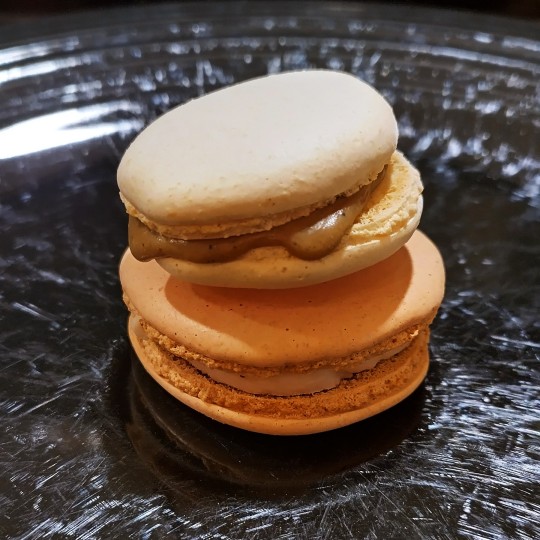
52 Cookies
The list of all the new cookie recipes I tried in 2024, with notes, in chronological order.
Chocolate peanut butter chip (Snacking Bakes) - 3/5 - need to remake when I'm COVID-free
Soft grapefruit (Snacking Bakes) - 4.5/5 - great afternoon tea cookie
Potato chip chocolate chip (Baking Yesteryear) - 5/5 - no notes
Oatmeal raisin (Snacking Bakes) - 2.5/5 - they're fine, but it turns out I don't like cinnamon and nutmeg in my oatmeal cookies
Brown butter oatmeal chocolate chip (Half Baked Harvest)- 4/5 - great right out of the oven, a little drier than I'd like once cooled
Parmesan galettes (Dorie's Cookies) - 5/5 - easy savory shortbreads, good cheese flavor, try with unsalted butter and/or Aleppo or black pepper
Marshmallow-Surprise Hot Cocoa Cookies (Sally's Baking Addiction) - 3.5/5 - Good concept, would ditch the hot cocoa mix and try marshmallow fluff next time
Homemade Nilla wafers (Smitten Kitchen) - 3/5 - 5/5 in the banana pudding, but 2/5 for a standalone cookie, too much work and expense (half a vanilla bean? in this economy?) for something that is dry and crunchy.
Classic Jammers (Dorie's Cookies) - 4.5/5 - used cherry jam; rave reviews from others, loses half a point for being a little fussy and non-feeezeable
Salted peanut butter cookies (Smitten Kitchen) - 2.5/5 - they're fine, I just don't like plain peanut butter cookies that much; used dark brown sugar which maybe contributed to the faint bitter/burnt aftertaste
Blueberry and Cream Cookies (Momofuko Milk Bar via Serious Eats) - 3/5 - they're fine; bonus points for being unusual but negative points for being fussy (have to make the milk crunch, then the cookies)
Micro chip cookies (Dorie's Cookies) - 3.5/5 - Will not become my go-to chocolate chip cookie, but they are fun to eat by the handful; would use 2 chips or extra large chunks next time
Coconut brown butter cookies (Smitten Kitchen) - 3.5/5 - a richer, more nuanced macaroon
The best soft chocolate chip cookie (Sally's Baking Addiction) - 3/5 - it's fine, but the mouthfeel was almost too dry even right out of the oven?
The best chewy chocolate chip cookie (Sally's Baking Addiction) - 3.5/5 - good classic chocolate chip cookie, but with an extra egg white left over
Cowgirl cookies (Baking Yesterday) - 3.5/5 - maybe too soft right out of the oven, would be better with dark chocolate chips instead of semi sweet, but good taste/texture
Supersized, Super-Soft Chocolate Chip Cookies (King Arthur Flour's 2024 Recipe of the Year) - 3.5/5 - Good texture, should have used 60% chocolate as recommended instead of 73%; not sure it's worth the the tangzhong step
Piloncillo Chocolate Chip Cookies (NYT Cooking) - 3/5 - They're fine, did not blow me away, molasses-y notes are noticeable if you're looking for them, not sure it's worth the effort of grating the piloncillo
Funfetti Cookies (Pillsbury) - 2.5/5 - tastes exactly like you'd expect boxed funfetti cake mix cookies to taste but the kids loved them & easy to make with them
Brown Butter Chocolate Chip Cookies (NYT Cooking) - 3.5/5 - Good classic chocolate chip cookie, slightly grainy texture, but with an extra egg white left over
New Favorite Chocolate Chip Cookies (Snacking Bakes) - 2.75/5 - They're fine, whole wheat flour and brown butter didn't seem very noticeable; not enough chocolate as written
Strawberry Lemon Cornmeal Cookies - (Snacking Bakes) - 3/5 - Nice enough, slightly bitter aftertaste maybe from the polenta
Guava Pinwheels (King Arthur Baking) - 3.5/5 - Tasty and interesting, but loses points because pastelitos are tastier and easier
New Favorite Chocolate Chip Cookie (Dorie's Cookies) - 3.5/5 - They're fine, maybe a little too chewy-crisp on the edges for my taste; did not use the spices
Churro Cookies (Sugar Spun Run) - 3.5/5 - Fun idea, tasty enough, but the ganache felt a little claggy after baking; maybe try again with just chocolate
Lemon Almond Cookies (lost the link) - 1.5/5 - Flavor was not bad, lemony and only mildly sweet, but the texture was terrible; I did overbake them and did not have enough almond butter so maybe it could be redeemed
two thick, chewy oatmeal raisin chocolate chip mega-cookies (Smitten Kitchen Everyday) - 3/5 - They're fine, exactly what I wanted when I already have a freezer full of cookie dough, but not that much easier than a regular recipe which can be frozen for later
Chocolate chunk cookies (Dominique Ansel - 3/5 - They're fine, a little claggy, maybe better cooled than fresh out of the oven, no vanilla and I feel like you miss it
Buttered popcorn cookies (The Smitten Kitchen Cookbook) - 3/5 - Had to make some substitutions due to limited ingredients at Sunday dinner, but not bad; popcorn didn't retain its crunch well, but maybe should have been made from scratch instead of microwave
Microwave chocolate chip cookies for two (Jane's Patisserie) - 2.75/5 - Not bad, not really a cookie texture even when baked, more like a chocolate chip biscuit; adequate in case of emergency
Breakfast cookies (Sally's Baking Addiction) - 2.75/5 - I always like the idea of almond butter more than the actual thing, and the combination of apple butter and cranberries made it too sour for me, but I'd try it again with some alterations
Peanut butter chocolate chip breakfast cookies (Sally's Baking Addiction) - 3/5 - Used butter and apple butter instead of coconut oil and bananas; I think the apple butter makes it ever so slightly too sour for me, but I'd tinker with it as an afternoon snack cookie
The Food Lab's Chocolate Chip Cookies (Serious Eats) - 4/5 - Good classic chocolate chip cookie, maybe what I've been searching for? Kind of fussy, brown butter & an overnight rest
Double Chocolate Chip Cookies (King Arthur Flour) - 3/5- They're fine, maybe a little dry once fully cooled; I think my cocoa powder was stale
Double Coconut Meltaways (Smitten Kitchen Every Day) - 4/5 - Vegan, really nice coconut flavor and good short texture; try again with lime zest?
Whole Wheat Oat Chocolate Cookies (Smitten Kitchen) - 3/5 - Good, a little dry for an everyday chocolate chip cookie
Quick and Easy Chocolate Chip Cookies (Serious Eats | BraveTart) - 3/5 They're fine, not as good as the SE version with brown butter, and it's getting harder to track down good quality plain dark chocolate in the grocery store
Snack Attacks (Snacking Bakes) - 3/5 - They're fine, I'd try them again if I've got snack-y things (chips, pretzels, etc) to use to, but not as good as the potato chip chocolate chip cookie
Strawberry Coconut Macaroons (Sally's Baking Addition) - 3/5 - They're fine, not as good as Mom's recipe and more fussy; strawberry doesn't really add anything
Levain Bakery-Style Super-Thick Chocolate Chip Cookies Recipe (Serious Eats) - 3/5 - Don't like the nuts; if I want an extravagant oversized chocolate chip cookie, I'd go with the KA Flour recipe or the NYT brown butter recipe, but fun for others who like the original
Our Favorite Chip Cookies (King Arthur Baking) - 2.75/5 - Too thin and crunchy, and too chewy/toothsome even fresh out of the oven, probably the ground oats; acceptable for others who like that kind of cookie
Chewy Chocolate Chip Cookies (King Arthur Baking) - 3/5 - They're fine, decent texture, not sure the corn syrup is doing anything; not the depth of flavor as the Food Lab ones
Bake Club Gooey Butter Cookies (Christina Tosi/Milk Bar) - 2.75/5 - A boxed cake mix recipe so maybe affected by shrink-flation; first underbaked then overbaked, but they're fine, still taste like boxed cake mix
Giant Crinkled Chocolate Chip Cookies (NYT Cooking) - 3/5 - They're fine, a little too thin and crispy for my taste and too fussy with the pan-banging, but would be fun with a group
Rye Chocolate Chip Cookies (King Arthur Baking) - 3/5 - They're fine, rye is subtle and mainly texture-y; I'd make them again to use up rye flour but wouldn't go out of my way for it
Double Lemon Thumbprints (King Arthur Baking) - 3/5 - Pleasant enough and easy, not as good as the Dorie Greenspan jammers
Marshall Fields Chocolate Iced Cookies (Chicago Tribune) - 3/5 - Surprisingly close to what I remember, including the vibe of being really close to a perfect cookie but not quite there
One Chocolate Chip Cookie (Dessert for Two) - 2.75/5 - Better than the microwave recipe, but still too claggy (maybe because no leavening agents?) and faintly sour (maybe my butter was too old); I like the idea of a cookie you can make if you're almost out of butter but I'd try a different recipe next time
Lavender White Chocolate Sables (Dorie's Cookies) - 2.75/5 - I always want lavender to taste better then it does for me, but the Sunday dinner crew liked them
Mint Chocolate Sables (Dorie's Cookies) - 3/5 - They're fine, good balance of mint and chocolate, a little fussy
Perfect Chocolate Chip Cookies (NYT Cooking) - 3/5 - They're fine, dry dough and comes out a little crisper after cooling then I prefer
Macarons (Dorie's Cookies) - 3.5/5 - A satisfying baking project and at least as good as Trader Joe's macarons
1 note
·
View note
Note
You didn't answer mu question.
Hm, hm. I don't know who you are. Are you the clerk from the grocery store who asked me if I wanted going to try the "Instant Double Spicy Raw Carp Flavor Polenta (NOW with ketchup and pieces of actual potato chips!!)"? In that case, no, I wasn't going to try that atrocity. Or are you, perchance, the person who scribbled "d2f?" on the back of my office chair? In that case, expect a defacing public property fine in your mailbox tomorrow.
0 notes
Text

Polenta Chips
PREP TIME10 minutes
COOK TIME1 hour

If you’re looking for a quick and easy snack that’s a healthier alternative to fried potato chips, then look no further than these flavourful polenta chips.
The secret to making them extra tasty is to use instant polenta and flavour the stock you cook it in. While plain water can result in a bland outcome, using a flavorsome vegetable stock infused with herbs, vegan parmesan, garlic powder, and onion powder will elevate the flavors to a whole new level.
Polenta, a staple in Italian cuisine, is not only affordable but also incredibly versatile. It’s made from ground cornmeal and was traditionally valued for its affordability, ease of preparation, and filling nature. In this recipe, we take polenta to the next level by transforming it into crispy and delicious chips.
Polenta Chips
PREP TIME10 minutes

Ingredients
1 litre water or vegetable stock (vegetable stock will be more flavoursome)
2 tablespoons olive oil
4 tablespoons vegan parmesan
1 teaspoon salt
1 teaspoon mixed Italian herbs
1 teaspoon garlic powder
1 teaspoon onion powder
250 grams instant polenta
Method
In a large pot bring to boil the vegetable stock or water with the olive oil, three tablespoons vegan parmesan, salt, Italian herbs, garlic powder, and onion powder.
Once it comes to a boil, gradually add the polenta and stir continuously with a whisk ensuring no lumps form. At this point taste to ensure seasoning is to your liking. Add more herbs or salt if necessary. Remove the rosemary.
Line a 20 x 20cm tin with baking paper and pour in cooked polenta. Smoothen surface.
Place in fridge for about an hour to set.
Once set, tip the polenta onto a wooden board and cut it into fries.
Place on a lined tray, sprinkle with salt and rest of vegan parmesan, and bake for 20 minutes. Turn the fries over and bake the other side for 20 minutes.
Serve with a dipping sauce of your choice.
Recipe Notes
Equipment you Need
Large pot
Whisk
20 x 20cm tin
Baking paper
Baking tray
Wooden board

To start, bring a large pot of vegetable stock (or water) to a boil, along with olive oil, few tablespoons of vegan parmesan, salt, herbs, garlic powder, and onion powder. Stir everything together to create a flavourful base for the polenta. Gradually add the polenta while continuously whisking to ensure a smooth texture without any lumps. Taste the mixture and adjust the seasoning if needed, adding more herbs or salt to suit your preference. Remove the rosemary from the pot.
Next, line a tin with baking paper and pour the cooked polenta into it, smoothing the surface. Place the tin in the fridge for about an hour to allow the polenta to set. This chilling process helps the polenta solidify, making it easier to cut into chips later on. Once the polenta has set, remove the tin from the fridge and carefully tip the solidified polenta onto a wooden board. Now comes the fun part—cutting it into chips! You can choose to cut them into thick chips for a hearty snack or thin fries for a lighter option. Use a sharp knife to create even slices, ensuring that each chip is of similar thickness.
Preheat your oven to 200 degrees Celsius (400 degrees Fahrenheit). Arrange the cut polenta on a lined baking tray, ensuring they are not too crowded, as this allows for even cooking and maximum crispiness. Sprinkle the chips with salt and the remaining vegan parmesan to add an extra layer of flavor. Pop the tray into the oven and bake for 20 minutes. After the initial 20 minutes, carefully flip the chips over using a spatula or tongs. This helps to ensure both sides of the chips become golden brown and crispy. Continue baking for another 20 minutes until the chips are beautifully crisp and golden.
Once your polenta chips are done, remove them from the oven and let them cool for a few minutes. They should be delightfully crunchy on the outside with a tender, creamy center. Serve your homemade polenta chips with a dipping sauce of your choice to enhance the flavor even further. Whether it’s a tangy tomato salsa, a creamy garlic aioli, or a spicy chipotle mayo, the choice is yours. The combination of the crispy chips and the flavorful sauce creates a mouthwatering experience that is sure to satisfy your snack cravings.
These polenta chips make a fantastic side dish or a tasty snack for any occasion. They’re a healthier alternative to traditional fried potato chips, as they are baked instead of fried. The use of instant polenta makes them quick and convenient to prepare, while the added flavors in the stock and the vegan parmesan elevate them to a whole new level of deliciousness. Plus, you can customize the seasoning to suit your taste preferences, adding herbs and spices of your choice to create a flavor profile that excites your palate.
#cooking classes#plant based cooking class brisbane#cooking course#plant based recipes#plant based cooking
0 notes
Text
Glasgow, Scotland: August 4-14, 2024
I had such plans for Glasgow and Edinburgh. I had multiple tickets to Edinburgh Fringe shows, I was going to attend a couple days of WorldCon, I bought a ticket for a bus tour of the highlands, I booked yet another high tea at a fancy place, I wanted to go to this bakery that puts swear words on their cookies, and I just wanted to explore both cities at length.
But none of that happened, because after taking a rest day following my travels on Monday, on Tuesday, August 6 I tested positive for COVID and spent the rest of my time in Scotland isolating in my hotel room. I assume I got it from the conference I spoke at the week prior, though I was very careful with masking.

So I spent 9 days feeling cruddy and isolating in my hotel room instead of seeing Scotland, which is a massive bummer.
Getting sick also necessitated my final Adventure in Doing Laundry being another pickup/delivery service, though this was a local service that was much cheaper than the one in Manchester, and they did same-day pickup and delivery, which was really nice. I'm thankful to the Rick Steves guide for recommending the Majestic Laundrette for this service.
I managed a couple brief, masked, walking/shopping excursions in Glasgow City Centre on days 7 and 8 of the infection and took a few photos. A small delight was seeing some bagpipe bands perform in the plaza next to my hotel, as part of the Piping Live! event running August 8-18.







Backing up, though, on my rest day August 5, before I got sick, I did have one adventure I'm quite pleased with.
The week prior, I hadn't eaten very well. Glastonbury has a number of excellent cafes, but they all close at 4 pm. For dinner, the options are pub food, fish & chips, takeaway Indian, and a couple expensive restaurants. So I mostly ate takeaway pizza and fish and chips all week. By the time I got to Glasgow, I wanted some good food.
In my Google Maps restaurant searches in Glasgow, I found a place called Six by Nico that was intriguing. Every six weeks, they have a new, fixed-price, six-course menu built around a theme. I booked a reservation for that night and holy crap was it amazing. Traveling solo for so long had really given me decision fatigue, and this was a great opportunity to walk into a restaurant, basically just say, "fuck me up," and be brought a bunch of food. No decisions necessary.
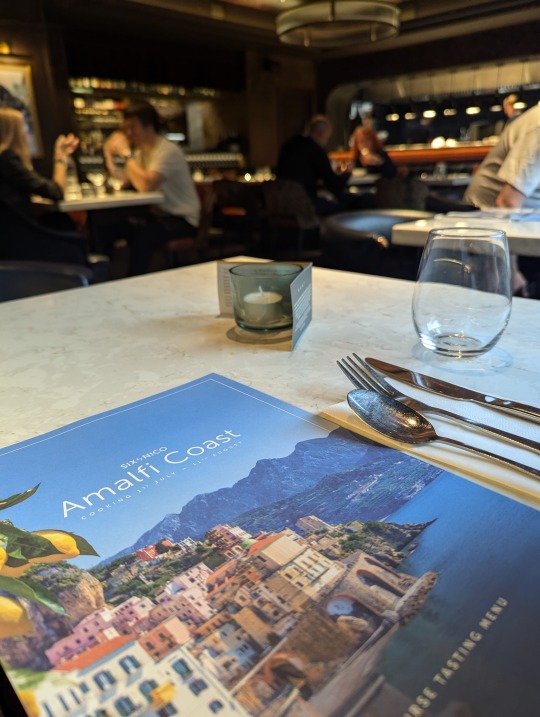
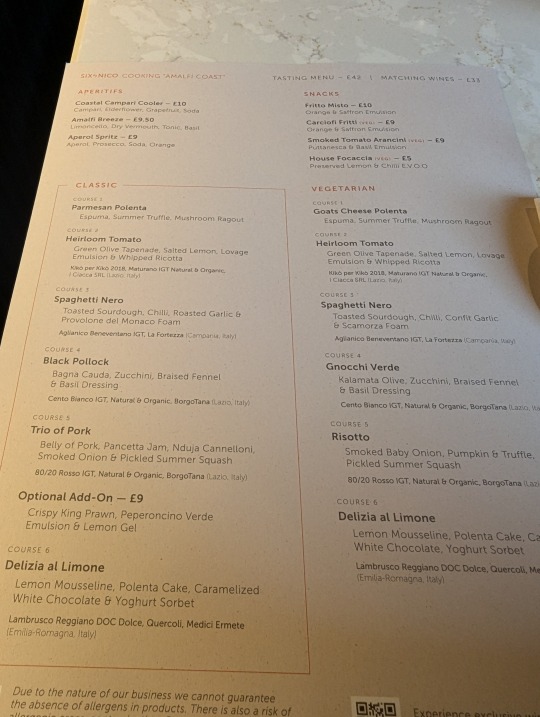
The menu was themed on the Amalfi Coast when I went.
Here's a better view of the courses I had:
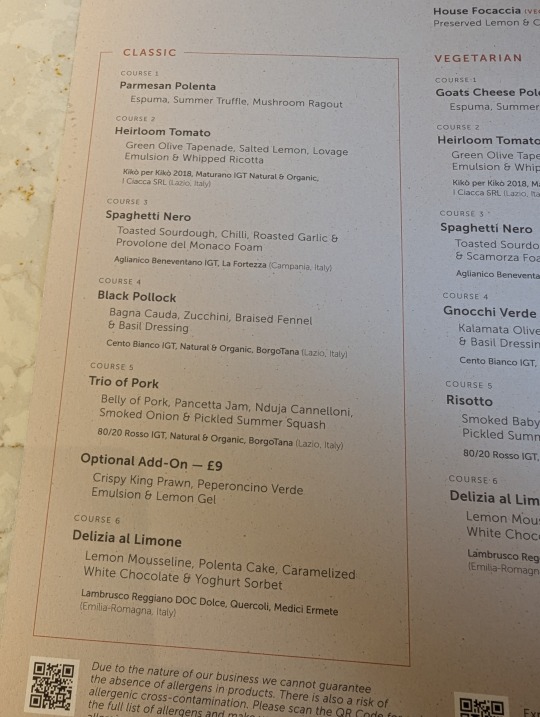
Course 1 was Parmesan Polenta. My notes: "OMG there's a mushroom party in my mouth and everyone's invited. Is it soup? Is it foam with a bunch of mushrooms in it? Who cares, I need it in my face."
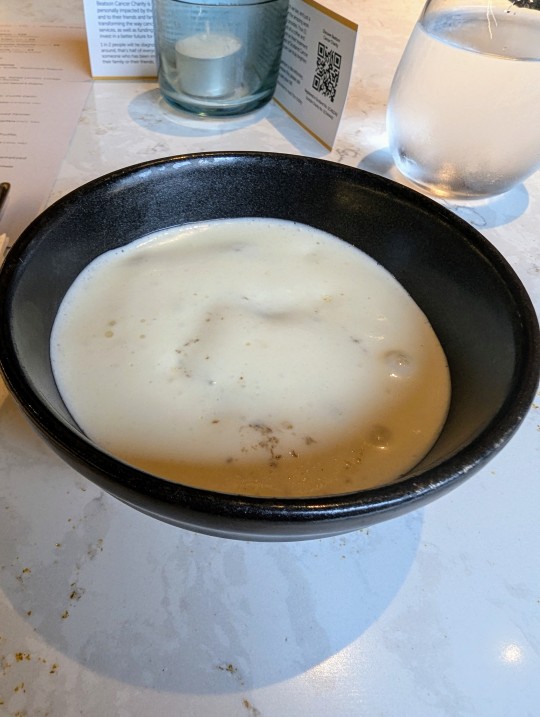
Course 2: Heirloom Tomato. My notes: "So many different tomato flavors, with bits of cream and olive. Love." I also got an Amalfi Breeze cocktail, which was super refreshing. Love the charred lime garnish.
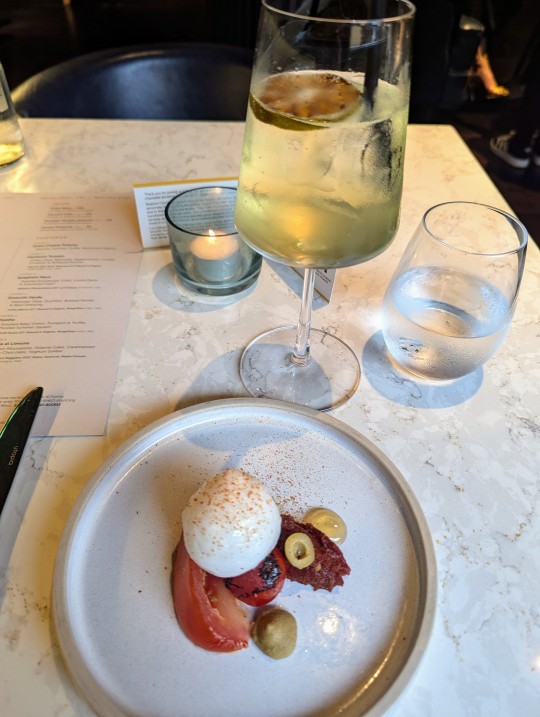
Course 3: Spaghetti Nero. My notes: "So many fun textures. Little crunchies, creamy, and soft. Nice blend of flavors though I can't taste the chili."
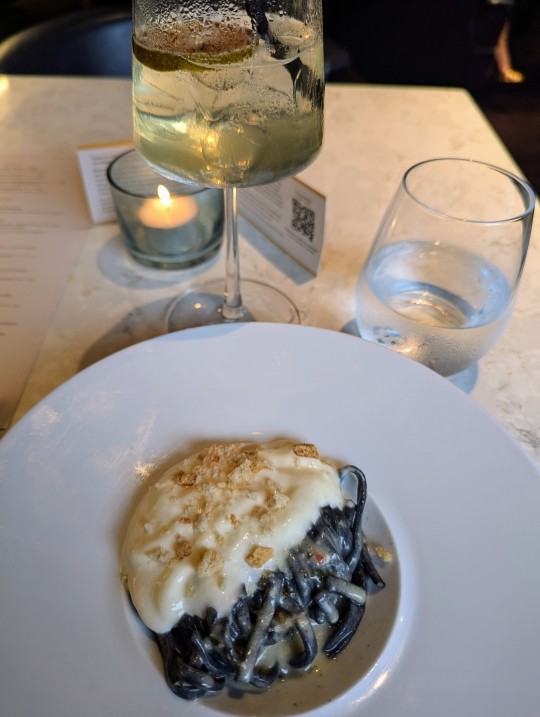
Course 4: Black Pollock. My notes: "Have I ever had fish this perfectly cooked? Crunchy outside, perfectly hot and tender inside. Basil sauce surprisingly subtle. Zucchini is nice too."

Course 5: Trio of Pork. My notes: "This is the first time I've heard the phrase "ham jam." [My server described it as such, though the menu calls it "pancetta jam."] Pork 1 delightfully smoky, like good bacon. Ham jam surprisingly good, somewhere between a thick chutney and crumbled sausage in texture. Bacon-wrapped sausage(?) spicy but nice. Also, I'm getting really full and glad there's only dessert left after this."

Course 6: Delizia al Limone. No, that's not a stick of butter on the plate. My (bleary with oncoming food-coma) notes: "Cold, creamy, lemony, rich white chocolate fudge(?), so refreshing after the heavy pork"
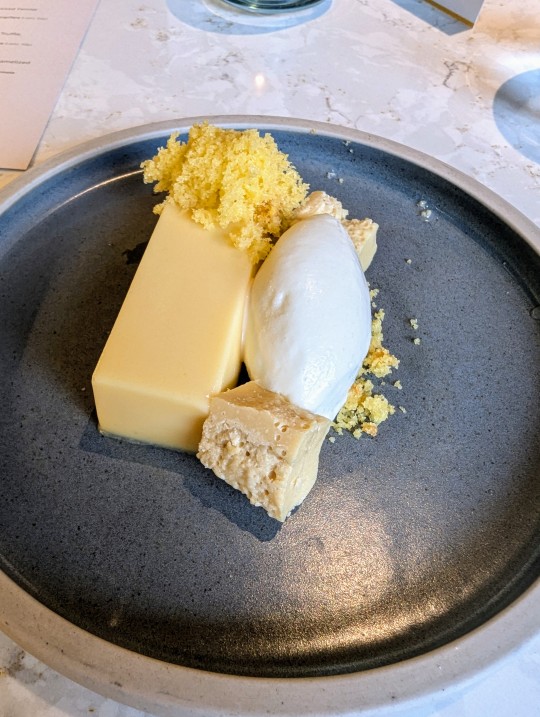
So I'm glad I had one little adventure in Glasgow before I got sick.
One other nice thing was that my day passes for WorldCon included access to their online content, which was plentiful and enjoyable. I got to see several panels on interesting topics from the comfort of my hotel room. A particular favorite was one on Shakespeare, King James, and Scottish Witch Trials. They also had a lot of queer-focused content, which I appreciated.
Some random funny things:
New burlesque name just dropped.
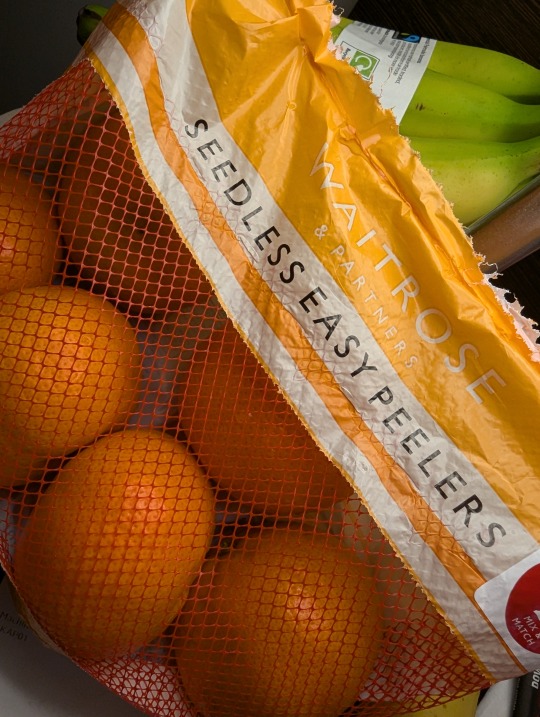
2. I do not like how my coronation chicken on baguette sandwich was labeled.

3. The airsick bag on IcelandAir is...something.

I flew home August 14 from Glasgow to Rekjavik to Baltimore, N95 masked the whole way (I didn't even dare eat on the plane). The descents were murder on my poor ears, but I was very glad to be home, even if I had to isolate in the guest house for a couple days before I finally tested negative.
1 note
·
View note